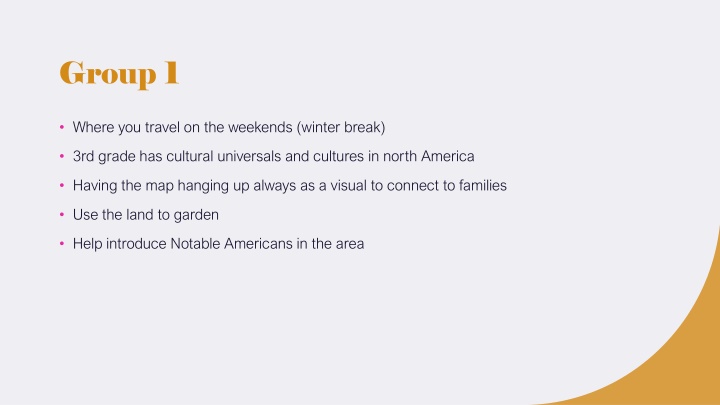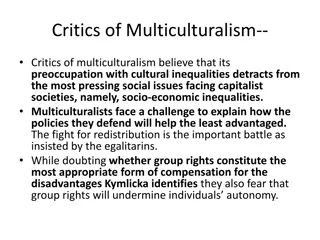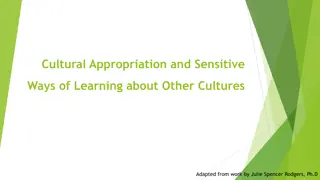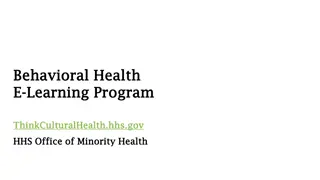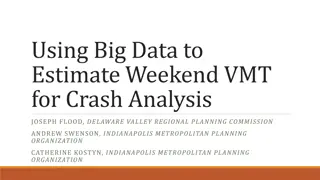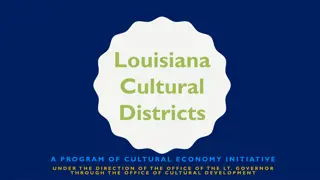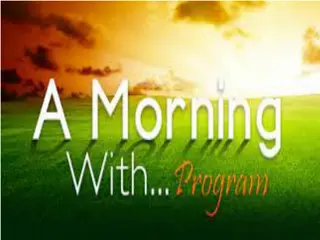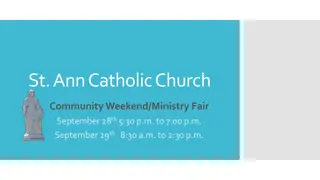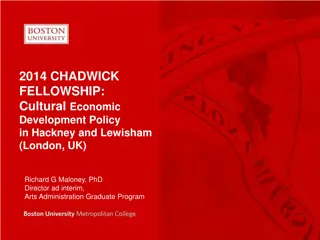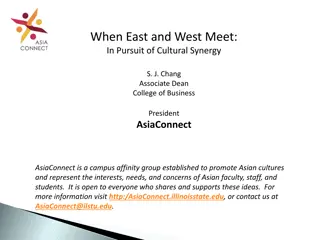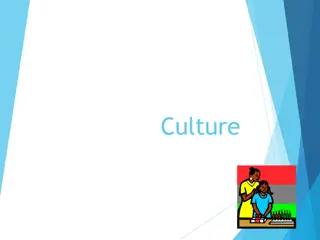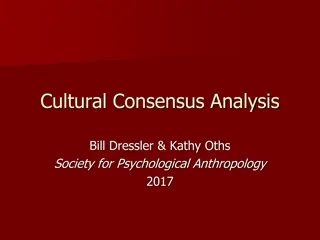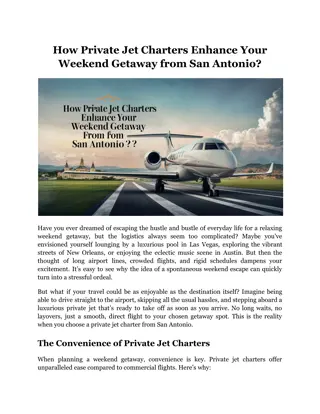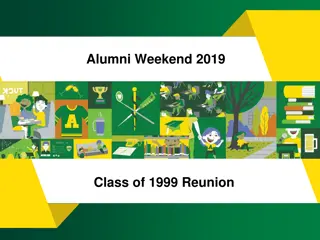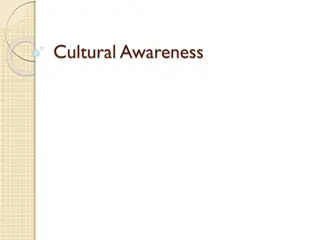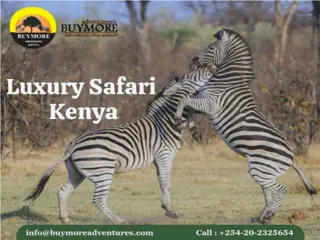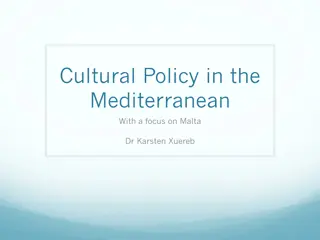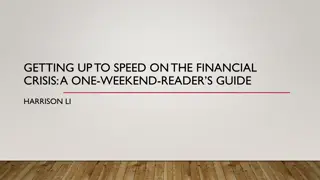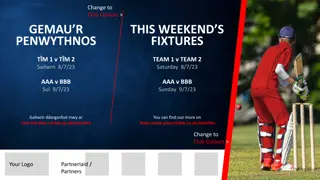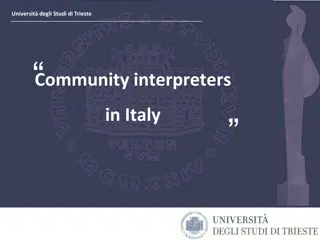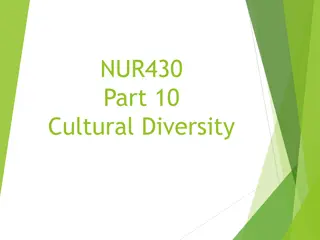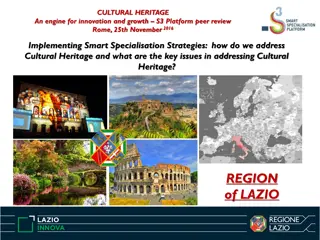Weekend Adventures and Cultural Education
Embark on weekend journeys exploring North American cultures and landscapes, utilizing maps, gardening, and showcasing notable Americans. Dive into Native American literature for younger students, emphasizing heritage and accuracy. Engage in activities like reading picture books, social studies units, and land acknowledgments throughout the year. Foster understanding of Thanksgiving's true meaning and connect with Indigenous Peoples Day and geology lessons.
Download Presentation

Please find below an Image/Link to download the presentation.
The content on the website is provided AS IS for your information and personal use only. It may not be sold, licensed, or shared on other websites without obtaining consent from the author.If you encounter any issues during the download, it is possible that the publisher has removed the file from their server.
You are allowed to download the files provided on this website for personal or commercial use, subject to the condition that they are used lawfully. All files are the property of their respective owners.
The content on the website is provided AS IS for your information and personal use only. It may not be sold, licensed, or shared on other websites without obtaining consent from the author.
E N D
Presentation Transcript
Group 1 Where you travel on the weekends (winter break) 3rd grade has cultural universals and cultures in north America Having the map hanging up always as a visual to connect to families Use the land to garden Help introduce Notable Americans in the area
Group 23 Notable Native Americans literature/document for younger students. 3rd or 4th grade specifically. Native American Heritage Month did Utube search for info and found several links to copy into lesson plans Research on good Native American Literature and received grant for books for their school. Curriculum should include/integrate Europeans and how they have been portrayed and not accurately. Guide Poster done in Spanish Chapter 4 vocabulary
Group 2 Keep Pictorial land acknowledgement up all year. Reading picture books Check with your equity team about picture books Seek ways for elementary PE and Music teachers to include activities in their curriculum
Group 3 4th and 5th Grade Social Studies Units help kick-off the unit and revisit throughout Put up the map in the classroom, tie it in to weekend updates Encourage families to visit different local tribal museums LHS created a video introducing the Land Acknowledgement along with an interview Share with students scientists/mathematicians who are indigenous to our area (Is there a resource available?) Begin Staff Meetings/PDs Begin Morning Announcements
Group 4 Land acknowledgement instead of Pledge daily Thanksgiving is a holiday of mourning, true meaning.
Group 5 Week of Thanksgiving Break- activities and lessons for what the holiday means and how it connects talk about the true meaning of it Daily morning routine land acknowledgement Directly relates to 5th grade social studies Leave the Land Acknowledgement map in the classroom- every student has their own Talking about the language
Group 6 Learning activity for Indigenous Peoples Day (went SO well with 2nd grade this year) Government and community units in 2nd grade Geology of the area/middle school earth science (7th grade)
Group 7 At Cougar Ridge 4th grade started the year with Social Studies doing the land acknowledgement lesson. They used some GLAD strategies to help teach the unit on the Snoqualmie Tribe. At Challenger, 2nd grade does the history of Issaquah and there is a lot about Snoqualmie Tribe. Did land acknowledgement with 5th grade class this year. The idea of having a working document is a great one. Kids could relate it to where they went skiing over the weekend or something else. Social Studies curriculum addresses some Snoqualmie Tribal history, but the land acknowledgement exercise brings it to life in the here and now.
Group 8 Being knowledgeable (as support staff) to help students as they are learning about land acknowledgements in the classroom. Increasing knowledge of the treaty and how that has played out Student's practice saying land acknowledgement together and work towards a student led morning meeting acknowledgement. Connections to the land we live on and talk about this with students/class.
Group 9 Student Centered Co-Teaching experience with a student Living document with personal connections and acknowledgement of ongoing activities. i.e: Salmon Days. Love the GLAD strategy to help all learners with reinforcement of concepts. Student could write (in different language) or draw pictures to add to the living wall. Acknowledgement in morning meeting, on-going. Video presentations to share with class and families on Seesaw.
Group 10 Model land acknowledgement with students Create a living document for classroom Refer to poster when students share experiences on the land Tie into geography or social studies Tie it into native plants and animals Incorporate story telling into learning Incorporate indigenous folklore and stories Students can listen to the story to de-escalate Way to orient new students and families to the land and area (students can lead) Present at assemblies
Group 11 Cultures/first SS unit in 3rd grade Geography/third unit in 3rd grade Living document- add to it often Literacy First People/first SS unit 5th grade Colonization/second SS unit of 5th grade Names and history of places
Group 12 A fifth grade teacher shared a GLAD land acknowledgement on Indigenous People's Day but now what? Do at assemblies? Start of WA geography (7th grade)? Build images onto it. Several student helpers say at part at assembly?
Group 13 Finding moments during SEL lessons, for example, to have students connect their personal lives with events and experiences with places on the land acknowledgement map and continue to do that for the rest of the year Click to add text Click to add text
Group 14 Loved the idea of a living document that we can continue to bring attention to 2nd grade social studies Places students visit Sharing with VOICE mentor program Speaking the same language in classrooms as with mentors Guest speakers / museum visits Noticing change over time Utilizing resources
Group 15 Parents have appreciated the conversations that students are having in class and continuing at home. Living document, to come back to throughout the unit and to continue the conversations between units Allows students to make connections Possible ways to make connections with science (weather unit in third grade?) Come back to it after breaks- have we made new connections? When is a good time to bring the map in when it doesn't fit into an exact lesson? In some grade levels it feels like a stretch to make it feel intentional in the curriculum
Group 16 Connect with WA state history, change how it's taught to bring in more cultural history and relating to what they see and experience on a daily basis. How to incorporate throughout our week to help students apply to their everyday lives Connecting wellbeing activities (nature/mindful walks & walking meditations) How could it be used in other spaces student experience in the school (health room, lunchroom, main office, counseling office, college & career space)? Including with other specialists? Or do we? Is it appropriate?
Group 17 Third Grade teaches both cultures & geography in Social Studies. Can have the visual land acknowledgment up all year and refer to it throughout the year. Second Grade covers national, local, and tribal governments as a good tie in. Maybe create the visual land acknowledgment at the beginning of the year and it can be up until those units are taught. US History has European and indigenous contact as a recurring theme and could use the visual acknowledgment up all year. Wondering about how to have students involved in the creation Weekend News or Journal sharing - could make connections to where students went/what they did (ex: hikes on Mt. Si) If there were suggested uses at each grade level, teachers could refer to what students may have done in previous grades to build on instead of always repeating the same thing
Group 18 Connecting to needs and wants (1st) Science units on animals, plants and survival SS unit on colonization (5th) Connecting to students' daily lives recreation
Group 19 Honor ancestors and connections to family Finding similarities with other cultures Attach photographs of the places and have students share about their experiences on that land. Could connect to narrative writing Teach environmental stewardship and show students how the mountains, rivers, lakes, and oceans are all connected
Group 20 Have you looked at other states for what they do for incorporating indigenous culture/history into curriculum? Montana has state standards that are solely focused on this so they (or other states) might be a good resources for authentic curriculum.
Group 21 New units in the seventh grade Washington State unit Connection to current events starting point with map Storyboard with creation stories Creation story in Language Arts classroom Discussing the creation story with religion in a Social Studies context
Group 22 1st grade- Connecting to our Social Studies curriculum and using maps to learn about a place (Our World) 2nd grade- Communities, history of our land and how Issaquah formed/on the tribal land Possible connections to Thanksgiving people coming on ships to our land but imagine settlers coming to Issaquah lands (perspective) Salmon Days- importance to the Snoqualmie Indian Tribe? 1st grade (Traditions & Celebrations) Should we include acknowledgements in things like email signature or other mediums? When is it appropriate to include?
Group 24 We use the land for recreation Swimming, snowboarding, hiking Salmon Days/Salmon Hatchery
Group 25 Morning Meeting (say land acknowledgement with pledge and say hello in different languages) Social Studies: 5th Grade: colonization (guided question is "Was America the land of opportunity for everyone?") 3rd Grade: cultural universals and notable Americans
Group 26 2nd grade integrate into plant and animal relationships "science" unit 3rd grade social studies unit on culture and geography; integrate into discussions of "notable Americans" 5th grade introduce before Colonization and Encounter
Group 27 1st Grade Weekend news (places they've been): add to the visual Science Unit: What humans need to live and grow add to the visual 1st Grade Plant & Animal defenses tie-in What can music do? Want to acknowledge and perhaps find something specific to this Land Acknowledgement movement (rather than just include a general indigenous 2nd Grade history of the land we live in (connect to this curriculum)
